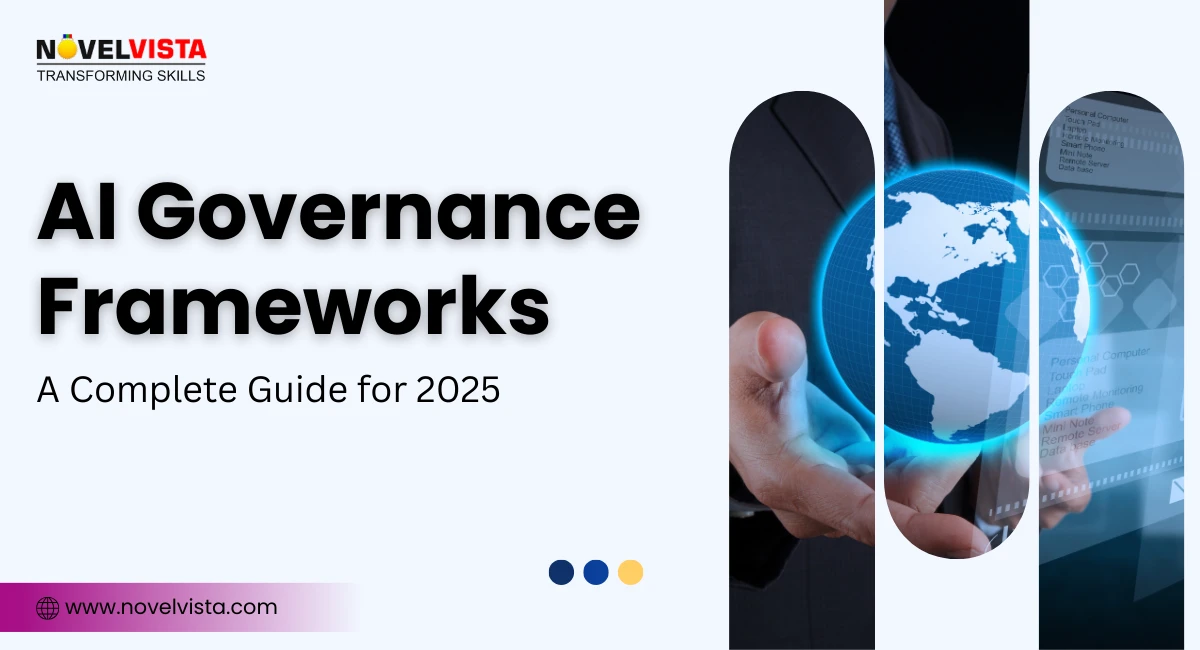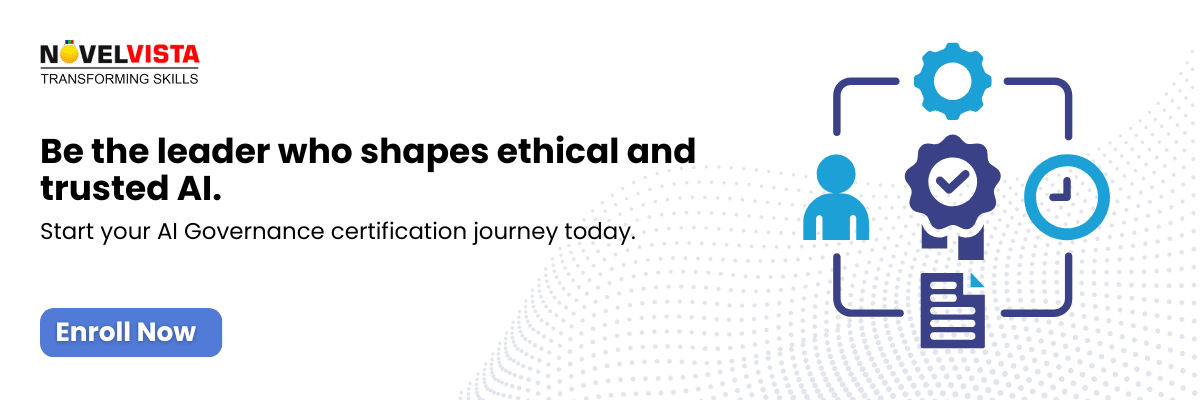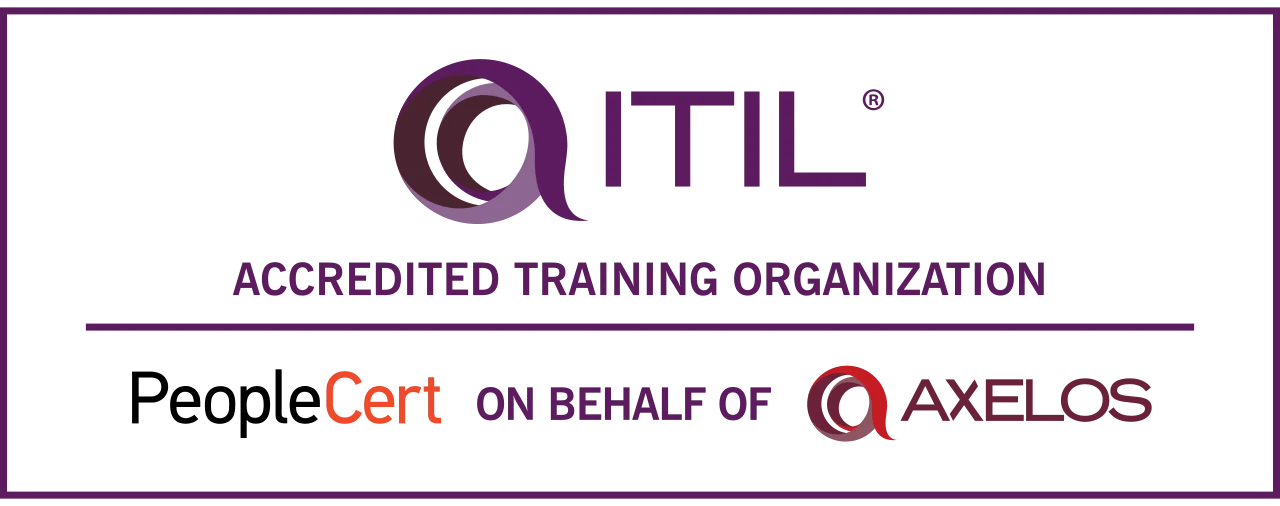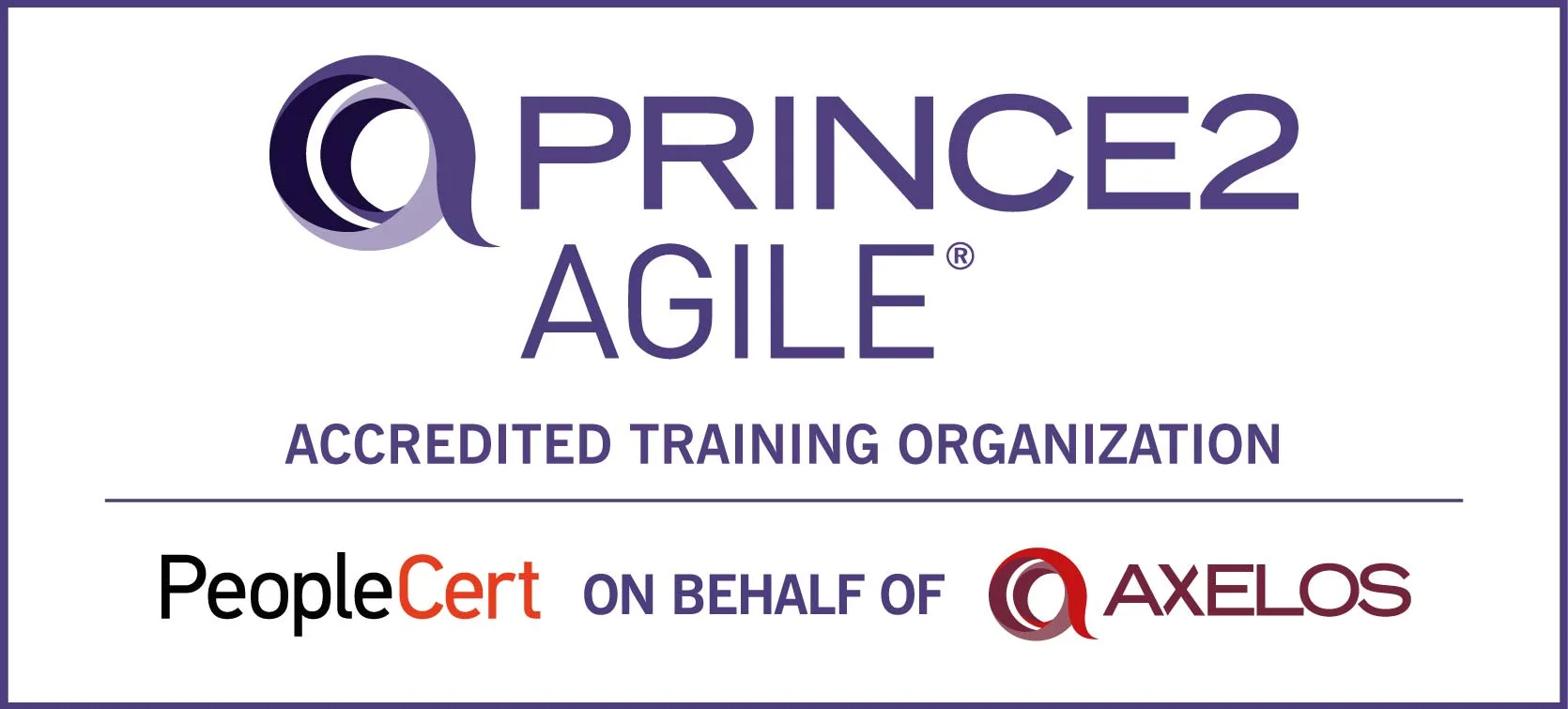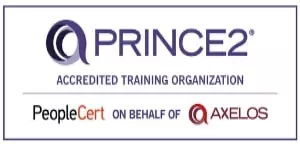- Why AI Governance Matters in 2025
- What is AI Governance?
- Principles and Standards of Responsible AI Governance
- Global AI Governance Frameworks in 2025
- Tools and Technologies for AI Governance
- Pros and Cons of AI Regulations
- How to Implement an AI Governance Program (ISO/IEC 42001 Example)
- Best Practices for Implementing AI Governance
- Who Oversees Responsible AI Governance?
- The Future of AI and Demand for Governance Professionals
- Conclusion
- Next Step
AI Governance Frameworks are the backbone of responsible artificial intelligence, setting the rules, principles, and safeguards that ensure AI is used ethically, transparently, and safely. In 2025, as AI reshapes industries like healthcare, finance, and retail, adopting strong AI Governance Frameworks isn’t just best practice; it’s essential for trust and compliance. Frameworks such as ISO 42001, the EU AI Act, and NIST AI RMF are leading the global movement in defining how organizations design, deploy, and monitor AI responsibly.
In this blog, we’ll explore these key AI Governance Frameworks, their core principles, and how they help businesses balance innovation with accountability in the age of intelligent systems.
Why AI Governance Matters in 2025
AI adoption is skyrocketing, and with it comes risk. Systems can unintentionally introduce bias, compromise data privacy, or even cause safety issues if not managed carefully. AI Governance Frameworks help organizations create structured approaches to manage these risks. They ensure AI decisions are explainable, accountable, and aligned with ethical principles. At the same time, governments and regulatory bodies are stepping in to enforce rules that protect people and businesses. Without proper governance, organizations risk legal penalties, reputational damage, and loss of customer trust.
What is AI Governance?
At its core, AI governance is about oversight and control over AI systems. It ensures that AI solutions operate ethically, comply with laws, and deliver value without causing harm. Here are the key components and objectives of AI governance:
- Ethical Oversight: Ensuring AI models are fair, unbiased, and align with ethical standards.
- Regulatory Compliance: Meeting the requirements of global regulations like the EU AI Act, NIST AI RMF, and emerging international standards such as ISO 42001.
- Risk Management: Addressing issues like bias, data privacy, cybersecurity, and operational failures.
- Transparency & Accountability: Mapping clear decision-making responsibilities and ensuring outcomes can be explained.
- Stakeholder Engagement: Involving internal teams, customers, regulators, and the public to maintain trust.
- Lifecycle Management: Overseeing AI from design to deployment and continuous monitoring.
- Continuous Improvement: Regularly reviewing and adapting governance practices to address new risks or business needs.
By integrating these elements, organizations can reduce risks and build AI solutions that are both reliable and responsible.
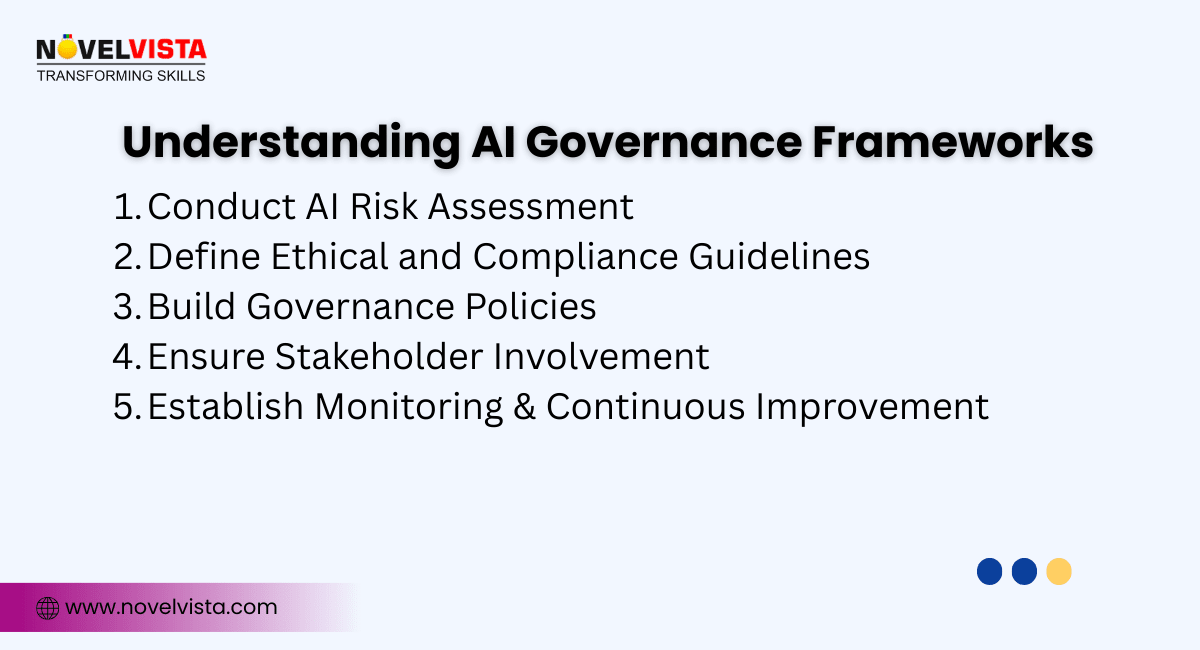
Principles and Standards of Responsible AI Governance
A strong AI Governance Framework goes beyond compliance, it builds trust, transparency, and accountability into every stage of AI design, deployment, and management. Responsible AI governance rests on a few universal principles that guide ethical and effective use of AI across industries.
Here are the key principles of responsible AI governance:
- Fairness: AI systems should make unbiased decisions and avoid reinforcing discrimination or stereotypes.
- Transparency & Explainability: Users and stakeholders should clearly understand how AI makes its decisions and what data it uses.
- Accountability: Human oversight is essential, every AI system must have defined responsibilities and clear governance ownership.
- Privacy & Security: Safeguarding sensitive data and ensuring compliance with privacy regulations is non-negotiable.
- Reliability & Safety: AI systems must operate consistently, predictably, and safely under all conditions.
These principles are supported by global standards like ISO 42001, the EU AI Act, and the NIST AI RMF, each helping organizations design AI responsibly. Together, they form the foundation of a trustworthy AI Governance Framework that balances innovation with ethical integrity.
Levels of AI Governance
A well-structured AI Governance Framework works across different levels of an organization, ensuring responsible AI practices from strategy to implementation. Each level plays a unique role in keeping AI ethical, compliant, and aligned with business goals.
Here’s how the levels of AI governance are typically structured:
- Strategic Level (Leadership & Policy):
Senior leaders define the organization’s AI vision, ethics, and compliance policies. They ensure AI initiatives align with business strategy and regulatory expectations.
- Operational Level (Implementation & Processes):
Teams translate high-level policies into practical actions, from developing AI models to managing data pipelines and security protocols.
- Technical Level (Model Development & Monitoring):
Data scientists and engineers ensure models are accurate, explainable, and continuously monitored for bias or drift.
- Compliance Level (Audit & Oversight):
Regular audits, documentation, and impact assessments verify that AI systems meet ethical and legal requirements.
Global AI Governance Frameworks in 2025
Several frameworks guide organizations in implementing AI governance effectively. Each framework has its focus, strengths, and challenges. Here’s a look at the most relevant AI Governance Frameworks in 2025:
EU AI Act (Europe)
A risk-based approach to classify AI systems based on their potential impact. It mandates strict compliance for high-risk AI applications, providing strong oversight but adding complexity for smaller organizations.
NIST AI Risk Management Framework (USA)
Focused on managing risk and ensuring transparency, this framework is voluntary but influential. It gives organizations flexibility but lacks enforceability.
ISO/IEC 42001 (International)
A standard for AI management systems that covers the entire AI lifecycle. It’s internationally recognized and provides structured guidance, though it requires expertise to audit and implement effectively.
OECD AI Principles (Global)
Emphasizes ethics, fairness, and human-centered AI. It’s widely adopted for guidance, but remains high-level and less practical for detailed implementation.
China’s AI Governance Principles
Focuses on responsible innovation, security, and national alignment. It helps organizations comply with local regulations but may not be suitable for global adoption due to limited recognition outside China.
Comparative View of Global AI Governance Frameworks (2025)
Framework |
Region |
Focus Areas |
Strengths |
Challenges |
EU AI Act |
Europe |
Risk-based AI classification |
Strong compliance structure |
Complex for SMEs |
Complex for SMEs |
USA |
Risk management & transparency |
Flexible & voluntary |
Limited enforcement |
ISO/IEC 42001 |
Global |
End-to-end AI governance lifecycle |
International recognition |
Requires auditing expertise |
OECD Principles |
Global |
Ethical oversight & fairness |
Widely adopted |
High-level, less practical |
China’s Guidelines |
China |
Responsible innovation & security |
National-level alignment |
Limited global adoption |
These AI Governance Frameworks help organizations understand regulatory expectations, reduce risks, and implement consistent AI practices across regions.
Download: Ethical AI Usage Checklist
Get audit-ready for ISO 42001. A must-have resource for aspiring Lead Auditors to ensure fairness and compliance.
Tools and Technologies for AI Governance
Building a strong AI Governance Framework isn’t just about rules, it’s about using the right tools and technologies to enforce them effectively. Here are some essential tools that help organizations manage AI responsibly and transparently:
- Model Monitoring Platforms: Tools like Fiddler AI, Arize AI, and WhyLabs continuously track AI performance, detect drifts, and ensure fairness and accuracy post-deployment.
- Bias Detection and Explainability Tools: Solutions such as IBM Watson OpenScale, Google’s What-If Tool, and SHAP help identify algorithmic bias and explain how models make decisions.
- Data Governance Solutions: Platforms like Collibra and Informatica ensure data integrity, lineage, and compliance with privacy regulations such as GDPR and CCPA.
- AI Policy Management Systems: Frameworks like Trustworthy AI Toolkits from Microsoft or Ethical AI Checklists help define, track, and enforce governance policies across AI projects.
- Risk and Compliance Platforms: Tools such as OneTrust and ServiceNow GRC help organizations manage regulatory compliance and monitor AI-related risks in real time.
- Audit and Documentation Tools: Platforms like Model Cards and Datasheets for Datasets provide standardized documentation for model transparency and accountability.
When integrated properly, these tools strengthen your AI Governance Framework, making it smarter, more transparent, and easier to scale across the organization.
Pros and Cons of AI Regulations
Pros:
- Reduces legal, financial, and reputational risks.
- Builds trust with customers, regulators, and partners.
- Offers a roadmap for responsible innovation and compliance.
Cons:
- Compliance can slow down innovation due to additional overhead.
- SMEs and startups may find implementation complex.
- Differences across regions create challenges for global organizations.
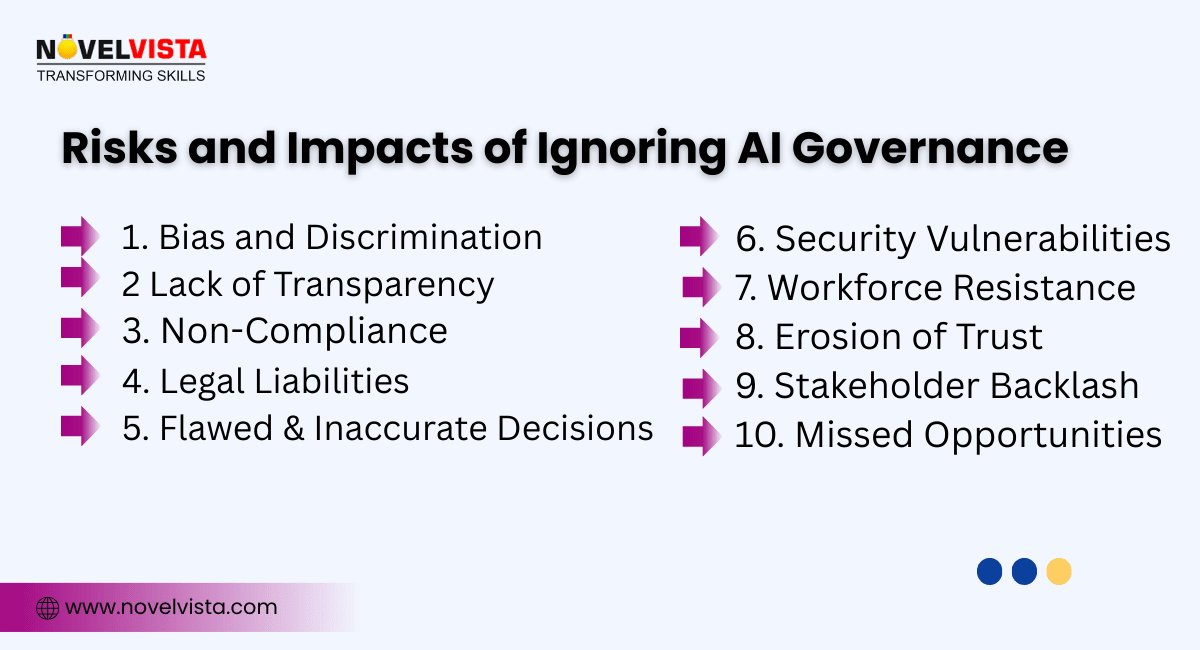
How to Implement an AI Governance Program (ISO/IEC 42001 Example)
- Conduct AI Risk Assessment: Identify potential risks like bias, data misuse, or cybersecurity threats.
- Define Ethical and Compliance Guidelines: Align with ISO 42001 and other relevant regulations.
- Build Governance Policies: Create structured processes covering AI design, development, deployment, and monitoring.
- Ensure Stakeholder Involvement: Involve internal teams, external regulators, and customers to ensure transparency.
- Establish Monitoring & Continuous Improvement: Regularly review AI performance and governance policies to adapt to new risks.
A practical roadmap ensures organizations can adopt AI responsibly while complying with international standards.
Best Practices for Implementing AI Governance
Implementing an effective AI Governance Framework takes more than just policies, it requires culture, structure, and consistent action. Here are some best practices to make AI governance work in real-world settings:
- Define Clear Roles and Responsibilities: Assign accountability at every level, from leadership to developers, to ensure ethical AI ownership across teams.
- Start with a Governance Roadmap: Outline goals, priorities, and milestones before deploying AI systems to ensure alignment with business objectives and compliance standards.
- Ensure Data Quality and Transparency: Use clean, unbiased, and well-documented datasets. Transparency in data sources builds trust and reduces bias.
- Integrate Governance into Development: Embed AI governance principles directly into the AI lifecycle, from model design to post-deployment monitoring.
- Regularly Audit and Review: Conduct ongoing risk assessments, fairness checks, and compliance audits to keep your AI systems accountable and up to date.
- Foster a Responsible AI Culture: Train employees, promote ethical awareness, and encourage open discussions about AI’s societal and business impacts.
When organizations follow these best practices, their AI Governance Framework evolves beyond compliance, becoming a strategic tool for innovation, trust, and sustainable growth.
Who Oversees Responsible AI Governance?
As AI adoption increases, effective governance is crucial. Multiple stakeholders are involved in overseeing responsible AI use:
Internal Stakeholders:
- AI Ethics Boards: Responsible for setting ethical guidelines, ensuring fairness, and addressing biases in AI models.
- Compliance Officers: Ensure AI systems comply with relevant regulations and industry standards.
- Data Security Teams: Monitor data usage, encryption, and compliance with data protection laws.
External Stakeholders:
- Regulators and Auditors: Government and industry regulators enforce laws such as the EU AI Act and data privacy regulations.
- ISO 42001 Lead Auditors: Lead auditors ensure organizations comply with international AI management standards, helping businesses maintain their AI governance practices in alignment with global best practices.
This collaborative governance structure helps ensure that AI systems remain ethical, compliant, and transparent.
The Future of AI and Demand for Governance Professionals
The future of AI is set to witness massive growth, with businesses increasingly reliant on AI systems. Consequently, the demand for skilled professionals in AI governance is expected to soar in 2025 and beyond. Here's what to expect:
Rising Demand for Governance Experts:
- AI Governance Specialist: Professionals skilled in ensuring ethical AI use and compliance with various regulatory frameworks.
- Responsible AI Officer: A dedicated role for managing ethical considerations, fairness, and transparency in AI development and deployment.
- ISO 42001 Lead Auditors: Specialized professionals who ensure organizations implement AI governance in line with international standards and best practices.
As AI becomes more embedded in everyday business operations, the need for these governance roles will continue to grow. Professionals in these fields will enjoy career advancement opportunities and the ability to shape the future of AI.
Governance as a Competitive Advantage:
Organizations adopting strong AI governance frameworks not only comply with regulations but also gain a competitive edge. With a solid governance structure, businesses can attract more customers, partners, and investors who value transparency, fairness, and responsibility in AI use. This makes AI governance an essential component of long-term organizational success.
Conclusion
AI governance is no longer just a regulatory necessity; it’s a strategic advantage. In 2025, the demand for responsible AI use is higher than ever, and organizations must adopt robust frameworks to stay compliant, ethical, and competitive.
By understanding and implementing AI governance practices, businesses can build trustworthy AI solutions that benefit customers, stakeholders, and society. The role of ISO 42001 and other regulatory frameworks is central to ensuring that AI continues to be a force for good, advancing industries while minimizing risks.
Next Step
Ready to lead the charge in responsible AI governance? As AI continues to reshape industries, professionals equipped with the skills to manage and audit AI systems are in high demand. NovelVista’s ISO 42001 Certification Training offers you the tools to stay ahead, ensuring your career is future-proof while helping organizations navigate the complexities of AI compliance and governance
Join the growing field of AI governance and ensure that your organization is prepared for the challenges and opportunities ahead.
Enroll today and become a leader in the responsible deployment of AI!
Frequently Asked Questions
Author Details

Akshad Modi
AI Architect
An AI Architect plays a crucial role in designing scalable AI solutions, integrating machine learning and advanced technologies to solve business challenges and drive innovation in digital transformation strategies.
Course Related To This blog
ISO 42001 Lead Auditor
Confused About Certification?
Get Free Consultation Call

